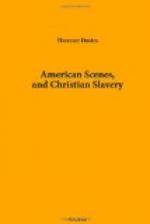On Saturday, the 30th, we set off to seek private lodgings. Led by a board having on it in large letters the words “Private Boarding,” we “inquired within,” found what we wanted, and engaged for eight dollars per week each. We then went to pay our bill at the “St. Charles’s,” and to bring away our carpet-bag. We had been there two nights, had had one dinner, two teas, and two breakfasts. These meals, as we did not like to join the hundreds at the “ordinary,” were served to us (in a very ordinary way however) in our bedroom. In fact, the waiting was miserably done. And yet for this we had the pleasure of paying eleven dollars,—say L2. 6s.! We gladly bade adieu to the “St. Charles’s.” It suited neither our taste nor our pocket. Nevertheless, it is a magnificent concern. The edifice was finished in 1838 by a company, and cost 600,000 dollars. The gentlemen’s dining-room is 129 feet by 50, and is 22 feet high; having four ranges of tables, capable of accommodating 500 persons. The ladies’ dining-room is 52 feet by 36. The house contains 350 rooms, furnishing accommodation for between 600 and 700 guests; and it was quite full when we were there. The front is adorned with a projecting portico, supported by six fine Corinthian columns, resting upon a rustic basement. The edifice is crowned with a large dome, forty-six feet in diameter, having a beautiful Corinthian turret on the top. This dome is the most conspicuous object in the city. Viewed from a distance, it seems to stand in the same relation to New Orleans as St. Paul’s to London. The furniture of this immense establishment cost 150,000 dollars. A steam-engine, producing a very disagreeable tremor, is constantly at work in the culinary department.




